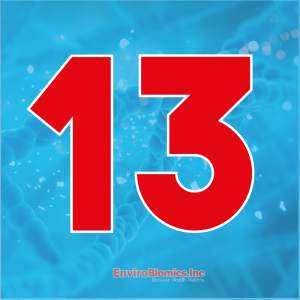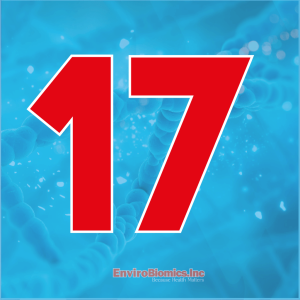Description
- The analysis is performed by LC/MS/MS
- Turn around time (TAT) ~15 Day’s 50 Plus Mycotoxins
Mycotoxin/Biotoxins.
Bioanalytical test performed with the high sensitivity LC/MS/MS ion-trap technology to detect and quantify Mycotoxins
Mycotoxins are toxic chemicals that are present in spores and small fragments of mold that are released into the air and dust.
| Aflatoxin | Gliotoxin | Sterigmatocystin |
| Aflatoxin B1, B2, G1, G2, M1, P1 | Gliotoxin | Sterigmatocystin |
| Averufin | Bis(dethio)methylthiogliotoxin | Seco-Sterigmatocystin |
| Averufin-Derivat | Bismethylgliotoxin | Trichothecenes |
| Versicolorin A, C | Bis(methylthio)gliotoxin | Dihydrotrichotetronine |
| Chaetoglobosins | Mycophenolic | Nivalenol |
| Chaetoglobosin A, D | Mycophenolic Acid | Nivalenol-Glucosid |
| Citrinin | Mycophenolic acid IV | Roridin A |
| Dihydrocitrinone | Ochratoxin | T2-Tetraol |
| Citreoviridin A | Ochratoxin A, Alpha, B, C | T2-Toxin |
| Citrinin | Penicillium | T2-Triol |
| Enniatin | Brevianamid A | Zearalenone |
| Enniatin A, A1,B, B1, B2, B3 | Brevianamide F | Zearalenone |
| Fumonisins | Griseofulvin | Zearalenone-4-Sulfate |
| Deoxynivalenol | Patulin | |
| Deoxynivalenol-3-Glucoside | Penicillic acid | |
| Fumagillin | Penitrem A | |
| Fumifungin | rugulosin | |
| Fumigaclavine, A, C | Verruculogen | |
| Fumiquinazolin A, D, F | Viridicatum toxin | |
| Fumiquinazolin Derivat | Xanthomegnin | |
| Fumitremorgin A, C | Roquefortine | |
| Fumonisin A1 precursor | Roquefortine C, D, E | |
| Fumonisin B, B2, B3 |
| Species | Limit of Detection | Species | Limit of Detection | |||
| Aflatoxin | Penicillium | |||||
| Aflatoxin B1 | 1 | Brevianamid A | 1 | |||
| Aflatoxin B2 | 2 | Brevianamide F | 1 | |||
| Aflatoxin G1 | 1 | Griseofulvin | 5 | |||
| Aflatoxin G2 | 4 | Patulin | 21 | |||
| Aflatoxin M1 | 2 | Penicillic acid | 35 | |||
| Aflatoxin P1 | 11 | Penitrem A | 4 | |||
| Averufin | 0.3 | Rugulosin | 2 | |||
| Averufin-Derivat | 2 | Verruculogen | 180 | |||
| Versicolorin A | 0 | Viridicatum toxin | 71 | |||
| Versicolorin C | 0 | Xanthomegnin | 18 | |||
| Chaetoglobosin | Roquefortine | |||||
| Chaetoglobosin A | 350 | Roquefortine C | 9 | |||
| Chaetoglobosin D | 350 | Roquefortine D | 4 | |||
| Gliotoxin | Roquefortine E | 2 | ||||
| Gliotoxin | 35 | Sterigmatocystin | ||||
| Bis(dethio)methylthiogliotoxin | 4 | Sterigmatocystin | 0 | |||
| Bismethylgliotoxin | 18 | Seco-Sterigmatocystin | 1 | |||
| Bis(methylthio)gliotoxin | Trichothecenes | |||||
| Mycophenolic | Dihydrotrichotetronine | 35 | ||||
| Mycophenolic Acid | 1 | Diacetoxyscirpenol | 2 | |||
| Mycophenolic acid IV | 4 | Fusarenon X | 14 | |||
| Ochratoxin | Nivalenol | 5 | ||||
| Ochratoxin A | 2 | Nivalenol-Glucosid | 14 | |||
| Ochratoxin alpha | 35 | Roridin A | 5 | |||
| Ochratoxin B | 7 | T2-Tetraol | 12 | |||
| Ochratoxin C | 1 | T2-Toxin | 4 | |||
| Citrinin | T2-Triol | 53 | ||||
| Dihydrocitrinone | 9 | Zearalenone | ||||
| Citreoviridin A | 18 | Zearalenone | 1 | |||
| Citrinin | 1 | Zearalenone-4-Sulfate | 7 | |||
| Enniatin | ||||||
| Enniatin A | 0.1 | Cercosporin | 53 | |||
| Enniatin A1 | 0.1 | Cercozoa | ||||
| Enniatin B | 0.1 | Cereulide | 2 | |||
| Enniatin B1 | 0.2 | Chaconin | ||||
| Enniatin B2 | 0.2 | Chaetoglobosin A | 350 | |||
| Enniatin B3 | 0.01 | Chloramphenicol | 1 | |||
| Fumonisis | Chlorocitreorosein | 9 | ||||
| Deoxynivalenol | 5 | |||||
| Deoxynivalenol-3-Glucoside | 4 | Chrysogin | 2 | |||
| Fumagillin | 71 | Chrysophanol | 35 | |||
| Fumifungin | 140 | Chytridiomycota | ||||
| Fumigaclavine | Citreohybriddione | |||||
| Fumigaclavine C | 11 | Citreohybridinol | ||||
| Fumigaclavine A | 1 | Citreohybridinol | ||||
| Fumiquinazolin A | 7 | |||||
| Fumiquinazolin D | 7 | |||||
| Fumiquinazolin F | 71 | |||||
| Fumiquinazolin Derivat | 71 | |||||
| Fumitremorgin A | 9 | |||||
| Fumitremorgin C | 9 | |||||
| Fumonisin A1 precursor | 9 | |||||
| Fumonisin B1 | 14 | |||||
| Fumonisin B2 | 11 | |||||
| Fumonisin B3 | 11 | |||||
| Valinomycin | ||||||
| Valinomycin | 18 | |||||
MYCOTOXIN DETECTED BY OUR TEST
AFLATOXINS
Aflatoxins, a fungi strain family that affects plant products, have been linked to liver cancer, hepatitis, cirrhosis, and other health problems. Consuming contaminated plant products, eating meat or dairy from animals fed contaminated feed, or inhaling dust while working with contaminated products all result in exposure.
Aflatoxin B1 – The primary metabolite of aflatoxin B1, a mycotoxin produced by many species of the Aspergillus genus, is aflatoxin M1 (AFM1). Some of the most cancer-causing elements in the environment are aflatoxins. Age, sex, and food are only a few of the many variables that affect an individual’s vulnerability to aflatoxin. Beans, corn, rice, tree nuts, wheat, milk, eggs, and meat all contain the toxin aflatoxin. Human tissue samples have shown aflatoxin in cases of pulmonary aspergilloma. Aflatoxin can harm the liver, lead to cancer, impair mental function, cause hemorrhage in the abdomen, create a coma, and even kill. Leucocyte proliferation has been demonstrated to be inhibited by aflatoxin. Non-pruritic macular rash, headache, gastrointestinal dysfunction (sometimes severe), lower extremities edema, anemia, and jaundice are some of the clinical indications of aflatoxicosis. When ochratoxin and zearalenone are present, aflatoxin’s toxicity is amplified.
Aflatoxin B2 – The fungi Aspergillus flavus and Aspergillus parasiticus produce aflatoxin B2. It is also a toxin and carcinogen that contaminates food, primarily affects the liver and kidneys, and enters the body via the lungs, mucous membranes (nose and mouth), or even the skin, but it is less potent than aflatoxin B1.
G1 Aflatoxin – G1, like the other aflatoxins, is derived from a soil-borne fungus and contaminates a wide range of food products, including peanuts, cottonseed meal, oilseeds, vegetable oils, corn, and other grains used in human food and animal feed. Aflatoxin contamination is most prevalent in humid environments, particularly in tropical and subtropical areas.
Aflatoxin G2 – Despite being the least toxic aflatoxin, G2 is still harmful to humans and animals. Though less lethal than some other aflatoxins, G2 can cause liver problems (including cancer, chronic hepatitis, and jaundice) and appears to be involved in Reye’s syndrome. It, like all aflatoxins, can have a negative impact on the immune system.
TRICHOTHECENES
This group of mycotoxins contains approximately 170 different toxins that are produced by at least five different types of fungi. Some contaminate plants such as grains, fruits, and vegetables. Others flourish in soil and decomposing organic matter. Stachybotrys chartarum, also known as black mold, is notorious for producing several types of trichothecenes.
Satratoxin G – While all trichothecenes are extremely toxic, tests have revealed that Satratoxin G is the most dangerous to humans and animals. The dark mold Stachybotrys chartarum produces a variety of trichothecenes, but Satratoxin G and H are more abundant than other toxins.
Satratoxin H – While not all strains of black mold (Stachybotrys chartarum) produce mycotoxins, those that do typically produce multiple types, including Satratoxin H. Mold can be found on some agricultural materials as well as in damp or water-damaged environments. Mold appears to be a serious problem in North America, according to evidence.
Isosatratoxin F– Isosatratoxin F, another trichothecene mycotoxin produced by Stachybotrys chartarum, is one of the contributors to “sick building syndrome,” in which building occupants’ health issues are directly linked to time spent in mold-infected buildings. According to a World Health Organization Committee report from 1984, up to 30% of new and remodeled buildings are potential sources of health problems due to poor air quality.
Roridin A, like other macrocyclic trichothecenes, is produced by mold and has been linked to a variety of acute and chronic respiratory tract health issues. Experiments have shown that Roridin A can cause nasal inflammation, excess mucus secretion, and olfactory system damage.
Roridin E – Roridin E, The mold genera Fusarium, Myrothecium, Trichoderma, Trichothecium, Cephalosporium, Verticimonosporium, and Stachybotrys produce roridin E, a macrocyclic trichothecene (i.e. black mold). Trichothecenes are typically discovered in water-damaged structures, but they can also be discovered in contaminated grain. This extremely poisonous substance prevents peptidyl transferase activity, which decreases protein formation. Trichothecenes have been utilized in biological warfare since they are thought to be particularly poisonous. Macrocyclic trichothecenes are known to induce significant brain damage, immunosuppression, endocrine disruption, cardiovascular issues, and gastrointestinal distress even at modest exposure levels.
Roridin H – Affecting human and animal health in similar ways to other trichothecene mycotoxins, Roridin H is produced by mold, specifically Stachybotrys chartarum, which grows well on many damp building materials such as wood fiber, bards, ceiling tiles, water-damaged gypsum board, and air conditioning ducts.
Roridin L-2 – Molds, including black mold, produce this mycotoxin. Environmental tests, however, do not always detect Stachybotrys because its spores are large and heavy, and do not disperse easily into the air. Unfortunately, mycotoxin molecules, including the highly toxic Rorodin l2, are light and easily airborne, allowing them to be inhaled by building occupants.
Gliotoxin – Aspergillus fumigatus, the most common cause of mold diseases in humans, produces gliotoxin, a mycotoxin that suppresses the immune system. A. fumigatus, which is found in many homes and buildings, usually infects people with weakened immune systems but can be fatal: In immunocompromised people, invasive aspergillosis (IA) is the leading cause of death.
One of the most common food-contaminating mycotoxins is ochratoxin A (OTA), a toxin produced by various Aspergillus and Penicillium species. It’s also a common contaminant in water-damaged homes and heating ducts. Inhalation can also cause exposure in water-damaged buildings.
SOURCE OF MYCOTOXINS
ASPERGILLUS
Aspergillus is the most common mold in the environment. Crop and livestock damage has cost billions of dollars. Aflatoxin and ochratoxin are two of the most common Aspergillus mycotoxins. The liver is the primary target of these toxins. These toxins have been discovered in peanuts, corn, cotton, millet, rice, sorghum, sunflower seeds, wheat, and a variety of spices. They have also been discovered in eggs, milk, and meat from animals fed contaminated grains. Aspergillosis refers to diseases caused by Aspergillus. The respiratory system is the most common entry point for infection. When Aspergillus mold colonizes the lungs and forms granulomatous disease, it can cause severe asthma.
PENICILLIUM
More than 200 Penicillium species have been discovered. The most common of these species is Penicillium chrysogenum. It is commonly found indoors and is the source of many allergic reactions. Penicillium is also a known contaminant in a variety of foods. Penicillium can contaminate many different types of citrus fruits, but it can also contaminate seeds and grains. Penicillium’s ability to thrive in low humidity is one of the reasons it is such a common pest. Penicillium can be found in wallpaper, carpet, furniture, and fiberglass insulation in the home. Ochratoxin is the most common mycotoxin produced by Penicillium (OTA). Ochratoxin is a nephrotoxic substance, which means it harms the kidneys. It also causes cancer.
STACHYBOTRYS
Stachybotrys is a mold that is greenish-black in color. This mold can grow on cellulose-rich and nitrogen-deficient materials such as gypsum board, paper, fiberboard, and ceiling tiles. Stachybotrys is well-known for producing extremely toxic macrocyclic trichothecene mycotoxins. Stachybotrys produces two of the most common mycotoxins: roridin E and verrucarin. In addition to mycotoxins, the fungus produces nine phenylspirodrimanes and cyclosporine, both of which are powerful immunosuppressants. These immunosuppressors, along with the mycotoxin trichothecenes, may be responsible for Stachybotrys’ high toxicity.
FUSARIUM
Fusarium mycotoxins include zearalenone (ZEN) and fumonisin. Temperate climates are ideal for the growth of Fusarium fungi. They grow at lower temperatures than Aspergillus. Fusarium grows on a variety of grains, including corn and wheat, all over the world. Exposure to Fusarium mycotoxins can have both acute and chronic consequences. Abdominal pain, malaise, diarrhea, emesis, and death are all possible symptoms. ZEN has estrogenic properties and has been linked to reproductive problems.







Reviews
There are no reviews yet.